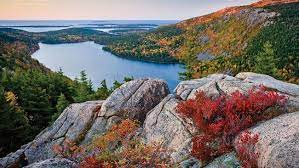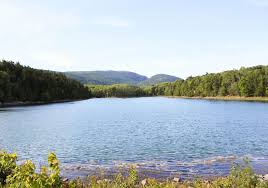Best time to visit Acadia National Park: 1916
Best time to visit Acadia National Park-
Akadia National Park is a natural national park known for its diversity. This national park has many ups and downs, mountains, Rivers, Vallie’s , High granite cliffs, dense forests, rich in wildlife, hundreds of species of birds, lakes rivers. This is a unique national park of America full of rivers, inaccessible mountains etc.
This park was established in July 8, 1916 and located in located southwest of Bar Harbour in the mid-section of the Maine coast-North-Eastern United States . On January 19, 1929, the park’s name was changed to Acadia National Park in honour of the historic French colony of Acadia.
As far as the area of this park is concerned, its area is spread over about 49076 acres. The main part of this park falls in Mount Desert Island of America.

It safeguards the natural beauty of the Atlantic coast’s rugged headlands, including the highest mountains.
This park is full of tallest mountain as well as having granite domes, U shaped valleys and large number of beaches. Its mountains contains large number of legs streams, wetlands , beautiful beaches , Mountains, a seaside coastline, woods, lakes, and ponds are all part of the park.
Acadia provides a long human history that dates back more than 10,000 years. For at least 12,000 years, Native Americans have lived in the Acadia region, which includes the coastal portions of Maine, Canada, and nearby islands.
Follow Our Digiknowledge.co.in Page for Latest update about Bikes, Cars, Sports, , Life style and many more.
Historical fire at Acadia National Park-
More than 10,000 acres of Acadia National Park were burnt in a fire that also devastated an additional 7,000 acres of Mount Desert Island outside the park beginning on October 17, 1947. In that unexpected fire more than Sixty-seven of Millionaires’ Row’s iconic summer cottages, as well as 170 additional properties and five hotels, were destroyed.
Climate- weather of Acadia National Park-
The region has a substantial seasonal temperature range, with warm to hot summers that are frequently humid and chilly to severely frigid winters. Weather: The coastal climate of Acadia National Park results in cool summers, chilly winters, and a lot of precipitation all year round.

With moderate daytime temperatures between 60°F and 80°F, summers are the most well-liked season to travel. There is snow during the winter, and the temperatures drop below zero.
Milder weather is available in the spring and autumn, but it’s important to check the forecast before travelling and pack appropriately.
Acadia National Park has a wide variety of plants and animals.
Acadia is home to mixed forests that are primarily made up of northern hardwoods and conifers. There include red spruce, balsam fir, and white pine.
- Wildflowers: In the spring and summer, the park blooms with colourful wildflowers such lupine, lady’s slipper orchids, and fireweed.
- seashore Plants: Coastal regions are home to salt-tolerant plants including beach rose, bayberry, and seashore goldenrod.
- Birds are among the flora. Acadia is a haven for bird watchers. Warblers, bald eagles, and peregrine falcons are among the birds that can be seen.
- Mammals: Watch out for moose, beavers, red foxes, and white-tailed deer. Various mammals can be found in Acadia’s varied ecosystems.
- Marine life: Along the coast, harbour seals, porpoises, and occasionally whales can be seen.
- The park is a popular destination for wildlife enthusiasts and nature photographers due to the biological diversity.
Map of Acadia National Park-

How to Reach at Acadia National Park–
Acadia National Park can be reached by a number of routes:
Most visitors travel by vehicle when they arrive. By car it is 4-5 hours drives . The park is reachable from major northeastern American cities like Boston, Massachusetts.
Air: Bangor International Airport (BGR), the closest sizable airport, is a one-hour drive from the park. Another possibility is the three-hour drive away Portland International Jetport (PWM).
Bus/Train: Although there is no direct bus or train service to Acadia, these modes of transportation can take you to adjacent towns from where you can rent a car or take public transportation to the park.
The visitor Centre and the main park loop road are both accessible from Bar Harbour. Throughout the summer, the Island Explorer, a free shuttle service, runs within the park, making it simple to get to all of the park’s attractions.
Famous Hotels and Campgrounds near Acadia National Park –
Camping, hotels, and other forms of lodging are available in Acadia National Park.
Hotels & Inns: Bar Harbour and other adjacent towns provide a selection of lodging options, from posh hotels to quaint bed and breakfasts.
The park has a number of campgrounds, some of which are extremely basic while others provide more amenities. In order to avoid disappointment, reservations are strongly advised during the busiest summer months.
Best time to visit Acadia National Park-
Your interests and the kind of experience you’re looking for will play a big part in determining the best time to visit Acadia National Park:
The most well-liked season for visiting Acadia is the summer (June to August). Daytime highs range from 60 to 80 degrees Fahrenheit, making the climate generally agreeable.
September through October: Visiting Acadia in the autumn is a wonderful experience. Golden aspen and vivid cottonwoods are only two of the trees that transform the park’s sceneries in the autumn. It’s a calm and beautiful time to explore as the crowds start to thin away.
Autumn is Best time to visit Acadia National Park when wildlife, including moose and deer, is more active.
Winter (November to March): Winter in Acadia offers a singular and quiet experience. Cross-country skiing and snowshoeing are available in the park as it transforms into a winter wonderland.
The park’s campgrounds and shuttle service are open during this time of year. It’s perfect for mountain biking, hiking, and taking in the breathtaking views of the shore and mountains in the park. But during this busiest travel period, expect more crowds, so make sure to reserve your lodging well in advance.
As a result, the ideal time to visit Acadia National Park will vary depending on your interests and the kind of experience you’re after. Every season has its own unique beauty, from the exuberant summer activities to the solitary winter, and from the gorgeous autumn foliage to the rebirth of spring.
When organizing your trip to this beautiful beauty, take into account your tastes and the activities you want to partake in.
What is the meaning of Acadia?
Acadia, a French baby girl’s name, translates as “place of plenty.” The word Acadia refers to a New France colony in northern North America.
What are the interesting facts about Acadia National Park?
The most interesting details and elements of the park.
Acadia was founded by private citizens, and the park’s name is derived from a Greek region.
Over 1,000 Plant Species Can Be Found in the Park.
There are 158 miles of hiking trails in Acadia, which has rapidly changing weather.
Are there guided tours available in Acadia National Park?
A variety of ranger-led programmes and escorted trips are available in the park. History, geology, and wildlife are some of the subjects covered in these programmes.
What wildlife can I see in Acadia National Park?
Acadia is home to diverse wildlife, including white-tailed deer, red foxes, beavers, and moose. Birdwatchers can spot peregrine falcons, bald eagles, and various songbirds. Coastal areas may offer opportunities to see seals, porpoises, and sometimes whales.




